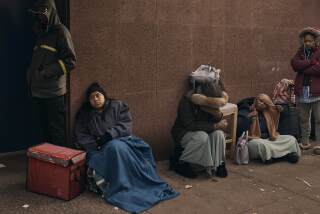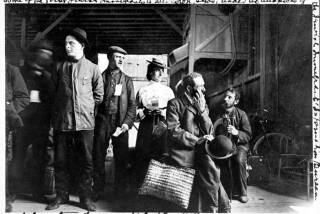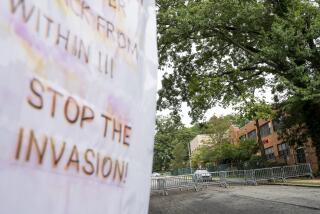An Indiana Alien Tests Survival Along the Sidewalks of New York
NEW YORK â âSo how do you like New York?â is the inevitable question for someone who left the bucolic world of small-town Indiana for the everything-that-is-not-bucolic world of Manhattan. Not just to work there but to live in. Norman Podhoretz once wrote that the longest journey in the world was from Brooklyn to Manhattan. He obviously never moved from Valparaiso (hard by Kouts and Boone Grove) to Manhattan.
The problem with the question is that, posed in its usual fashion, itâs quite unanswerable. Does anybody like New York? People love it, they hate it--often simultaneously--but when one is groping for words to describe the city, likable is not the first--or 47th--that leaps to mind. (Perhaps the only less likely term would be gracious .)
There is much about Manhattan that offends both the senses and elementary notions of common decency. It is incessantly noisy, unspeakably filthy. Because there are too many people in too close contact with each other, the most common attitude New Yorkers adopt toward their fellow citizens involves an admixture of distracted indifference, incipient hostility and impersonal rudeness. Most people most of the time do not even look at each other. To make eye contact in a public place is to risk sending an inadvertent message: a proposition, if one is female; a challenge or threat, if one is male. Perpetually overwhelmed by the presence of uncountable others, one constructs an invisible refuge of psychic isolation. As one of the characters in Tom Wolfeâs âThe Bonfire of the Vanitiesâ puts it, the essential need for the New Yorker is to âinsulateâ himself from and against the existence of all those other people.
We are speaking, of course, of life in public. There is no reason to suppose that New Yorkers act any differently in private among people they know than people anywhere else. And one does find exceptions to the public behavior described here--an open and friendly smile, a gesture of personal concern, a supererogatory act of courtesy--but those encounters are notable precisely for their singularity.
For a great many residents the daily descent into public life begins with the degradation ceremony otherwise known as the subway. It is said that as many people ride the New York subway during rush hour as live in the city of Chicago, and riders know that statistic to be, if anything, understated. New Yorkers on a daily basis achieve the most intimate familiarity with their neighbors; for those inclined to cheap thrills, the subway experience cannot be improved on.
Non-thrill-seekers cope as they can. Many read. Some sleep. Others retire into their headsets. Still others stare blankly into middle distance, apparently willing themselves into Zen nothingness. Some even pray. An acquaintance--not Roman Catholic--has taken to closing his eyes and reciting the rosary. (He finds the appeal to Mary to âpray for us sinners now and at the hour of our deathâ peculiarly compatible to the subway experience.)
If the subway itself wonât get you, the getting there will. Thereâs the crime factor, of course, though in fact fear for oneâs personal safety isnât nearly so pervasive a factor of daily life here as non-New Yorkers universally suppose (Relatives in Indiana report that the most common question asked concerning me is, âHowâs Jim? Has he been mugged yet?â). City life anywhere in America has its risks, but one does not walk the streets of Manhattan in perpetual fear. Common-sense wariness, yes, but not fear and trembling.
The assaults on the streets arenât so much physical as aesthetic and moral. Anything and everything of human experience or behavior routinely awaits the walker-- walker , not stroller ; to stroll in New York is to risk being trampled. Street scenes encompass the sublime and the horrific, including Hogarthian rawness. Wandering about the city, tasting its life, one feels fascination, excitement, loathing--everything but boredom, a sensation which, like serenity, is difficult to imagine in Manhattan. If New Yorkers typically exhibit the demeanor of those who have seen it all, it is because they have.
There are crazies everywhere. Not as in eccentric, but as in--to employ one of Mayor Edward I. Kochâs favorite terms--wacko. The unhinged rant on street corners, scream obscenities in crowded subway trains, carry on extended conversations with unseen partners (perhaps because they are so leery of speaking to each other, New Yorkers have a striking propensity for conducting audible discussions with themselves). People regularly fall asleep--pass out--in full view: in parks and playgrounds, on subway platforms, propped in doorways, sprawled on sidewalks.
Panhandlers are omnipresent, as are druggies, bag ladies, the homeless, the rootless and unsettled of every sort. On a small island like Manhattan, with a population piled on top of itself, extremes of wealth and poverty crowd upon each other with startling and ominous juxtaposition. Tom Wolfe exaggerates when he depicts the wealthy neighborhoods of Manhattan as besieged fortresses in an essentially Third World environment, but the image is closer to reality than is comfortable.
All this edges one toward the conclusion so often reached about the city--that it is unlivable. New Yorkers do not deny unlivability; indeed, they insist on it, wear it as a badge of honor. It is difficult in New York to think of life in other than Darwinian terms, and so the conceit comes easily that survival here marks one as among the fittest.
Even if, as some critics would insist, at a terrible cost. Callousness develops naturally in New York; it is in some ways simply a necessity. How else endure the routine horror? Even the most tender of spirits must sooner or later come up against the limits of compassion. One becomes, if not hardened, at least oblivious, unseeing.
Yet it is necessary to avoid facile moral conclusions and judgments. It is easy to be deceived by the surface cynicism and unconcern that New Yorkers put on as defensive armor. There is reason to suspect that conditions in the city are likely to generate increased, rather than lessened, compassion toward others. Where, after all, is it easier to avert oneâs gaze from the social miseries that people endure in America today: in Manhattan or in Valparaiso, Indiana? Homelessness and destitution are largely abstractions in Valparaiso; in New York they are inescapable daily realities. If New Yorkers of necessity affect indifference to the social pathologies that surround them, those pathologies nonetheless impinge on them with such pressing immediacy that they must--in some way, at some level--be attended.
At a recent dinner party in Manhattan, a spirited discussion developed as to whether or not city residents should make contributions to the panhandlers they encounter every day. Only after lengthy debate did someone notice that it was the longtime residents who made it a practice to fill their pockets with quarters each morning for distribution to the unsortable assortment of con artists and genuinely needy they would run into that day; the newcomers and out-of-towners preached sterner social morality and practiced less generous personal charity.
Which is not to suggest that the non-New Yorkers were necessarily wrong. Mayor Koch doesnât think so, and there is much to be said for his argument that giving money to street beggars is, after everything has been carefully weighed in the social balance, a counterproductive policy for all concerned. Nor is the mayorâs position congenial only to conservatives and the hard-of-heart; many compassionate leftists would insist that the only effective solution to social misery lies in public policy and that indiscriminate private charity misdirects social energy, delaying genuine reform.
The issues here for both morality and social policy are infinite in their complexity and ambiguity, but the evidence suggests that living in New York is not of itself necessarily destructive of moral sensibilities or injurious to moral health. It might even--and here, finally, the point of these rambling observations--be of some contingent value to one who has come to the city to help edit a journal concerned with the intricate interactions of religion and public life.
But all that may be mere rationalization. One quickly learns that Manhattan, for all that is awful about it, is also, by virtue of variety, vitality and sheer manic energy, damnably seductive. One even comes to understand, even if not yet to take on, the core belief on which most residents build their lives, a belief often conveyed in the form of a question: Given a choice, how could anyone who is not brain dead--and from whom the juices of life have not been entirely drained--live anywhere else?
More to Read
Sign up for Essential California
The most important California stories and recommendations in your inbox every morning.
You may occasionally receive promotional content from the Los Angeles Times.










